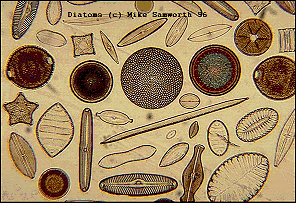
Articles on Micscape will have already shown you what a fascinating and diverse world can be seen under the microscope. Hopefully you will have begun to experience this for yourself by looking down the tube. However, there is always a point where assistance is needed, either in terms of use of the instrument itself, or in obtaining and preparing specimens for viewing. In this short article I intend to suggest where you can get such help.

Particularly in Victorian times, the microscope was a form of family entertainment for the wealthy. Indeed, it is probably fair to say that the heyday of both the amateur microscopist and the light microscope itself was during the latter part of the last century and the early part of this one. Diatoms were a favourite study subject, and many slides were produced with assorted and ingenuous arrangements of the silica cases (frustules) left behind when the microscopic algae had perished. It is astonishing to see slides made during this period where diatoms were often arranged into well known images such as Christmas trees or similar, simply to delight the viewer.
Many wealthy families owned microscopes and a Saturday evening may well have seen the entire family gathered around the microscope eagerly awaiting their glimpse into a hidden world of beauty. Hence such titles as Evenings at the Microscope‘ by P H Gosse, 1874, which opens with;
To open the path to the myriad wonders of creation, which, altogether unseen by the unassisted eye, are made recognisable to the sight by the aid of the microscope, is the aim and scope of this volume. Great and gorgeous is the display of Divine power and wisdom in the things that are seen of all, it may safely be affirmed that a far more extensive prospect of these glories lay unheeded and unknown, till the optician's art revealed it. Like the work of some mighty genie of Oriental fable, the brazen tube is the key which unlocks world of wonder and beauty before invisible, which one who has once gazed upon it can never forget, and never cease to admire.
Old books such as this, and newer ones, can provide ideas for what to look at and how. Some are very practical in nature and give techniques and instructions. However good they are though, I don‘t think you can beat direct help and advice from someone. To gain access to the numerous amateur microscopists in this country who are willing to help you can do no better than join the Quekett Microscopical Club, or QMC for short. Founded in 1865, this club is primarily concerned with helping amateur microscopists, that is you. It publishes a journal and bulletin, holds lectures and gossip meetings once a month in London and has a fine collection of instruments, books and slides. More than that though, it puts you in touch with fellow members, most of which are only to ready to share their enthusiasm and experience with you. There are some local groups based in Reading, the Midlands that meet from time to time, but the club produces an invaluable list of members addresses, together with their particular interests. You are bound to find someone near you, so contact them and hopefully you will have found a new friend who shares in your hobby.
David Bellamy‘s father was a Quekett member, and passed on his passion to his son. Let another Quekett member pass on some of their experience to you. You can find more information about the Quekett from this site.
You may like to view diatoms in more detail. Why not look at some for real. You will be amazed by the complex and fine patterns, like carefully etched symmetrical artwork, which cover the silica cases. Mike Samworth.
Please report any Web problems
or offer general comments to the Micscape Editor,
via the contact on current Micscape Index.
Micscape is the on-line monthly
magazine of the Microscopy UK web
site at Microscopy-UK